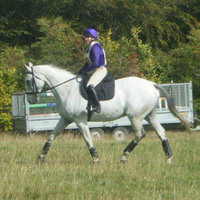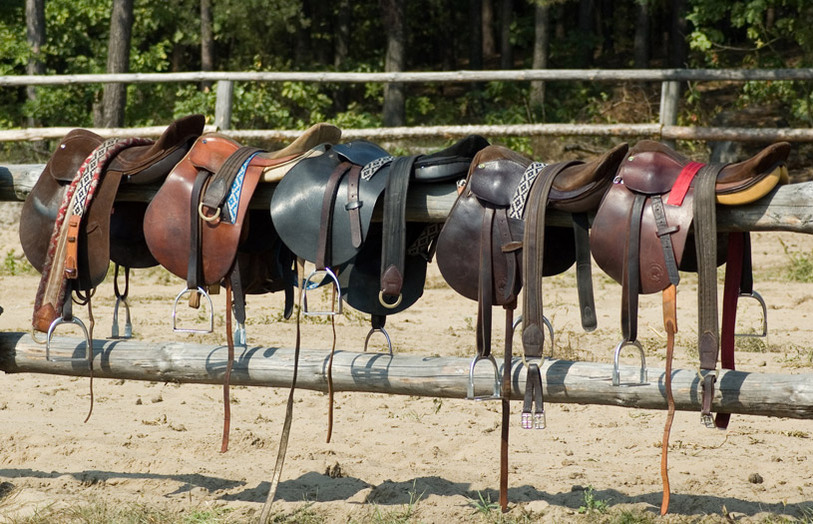
Are You & Your Horse Ready For Bitting Advice? The Steps You Need To Consider First
Equestrian Advice & Guides All Disciplines
Build your business profile for FREE and expose your services to thousands of potential clients!
Create my profile now!
There are generally considered to be two main types of riding style – Western and English. Western riding includes the disciplines of roping, reining, trail riding and barrel racing. English riding generally refers to the more familiar UK disciplines of dressage, show jumping, eventing and endurance. Each riding style has a different saddle design, which is then modified further to meet the demands of the individual disciplines.
The Western rider learns to guide their horse with one hand by neck reining, leaving the other hand free to perform the tasks required on a working ranch, such as roping. The rider sits upright in the saddle but with a very relaxed, balanced and comfortable looking posture.

In contrast, English disciplines require the rider to use both hands above the wither and keep the reins in a straight line to the mouth. The rider sits tall and straight in the saddle with the heels down, calves by the girth and the stirrup on the ball of the foot in a much more poised and placed posture.
However, there are interesting similarities between the designs of saddles used in the varying Western and English disciplines that provide a clue that similar riding styles are required.
Western saddles were originally designed for riders that spent long hours in the saddle. They have a wide, comfortable seat and high cantle. The weight bearing area of western saddles is large with the horn at the front of the saddle used for roping cattle. A good example is the ranch saddle; a heavy weight, sturdy saddle, providing comfort and functionality for long hours of riding and working cattle.

Similarly, the English endurance saddle is built with long distance riding in mind. The main purpose is to provide both horse and rider with comfort while they cover up to 100 miles per day. They are generally light weight with a flatter, wider seat and thankfully, quite well padded!
The riding style for both Western and English long distance riding is more relaxed and reminiscent of a seated style than the still poise required by the dressage saddle or the dynamism suggested by the jumping saddle.
The jumping seat (folding forward over fences rather than leaning back) was first developed in the early 20th century by Italian Cavalry Officer, Federico Caprilli. Those of us of a certain age may well remember his namesake, the Prix Caprilli, test which involved performing dressage style movements in a boarded arena with a jump in the middle to be performed at a specified point within the test!
The jump saddle is designed with show jumping, galloping and cross country in mind. The design aids the rider to adopt a 2 point, half or light seat position. It is made to be close contact so that the balance of the seat is set further back and is relatively flat. The cantle and pommel are lower so they don’t interfere with the riders position, particularly when jumping downhill. The flaps are set forward and well padded to accommodate the riders shortened stirrups and provide security and stability over fences and in the forward galloping position.

This design allows the rider to use their weight and balance to influence the horse. Bringing the weight back or becoming more upright in the saddle encourages the horse to balance itself and bring its weight more onto the hind legs. In addition, it allows the rider to remain secure through the body and leg whilst giving with the reins.
Polo, reining, roping and barrel racing saddles have much in common, with relatively flat seats and longer flaps to allow the rider to take a longer leg position but more forward set than a dressage style. There is little padding at the knee or thigh. In the case of a polo saddle, this allows the rider the freedom to lean, twist and have unrestricted use of the mallet throughout the game.

Roping saddles offer maximum freedom of movement so the rider can quickly and easily follow, chase and rope cattle. Reining saddles have forward hung stirrups designed to seat the rider back and deep for fast starts and stops. Barrel racing saddles are small, light weight and designed to allow maximum manoeuvrability while securing the seat during fast turns and sprints.

The designs of all these different saddles allow the rider to stay balanced whilst using the movement of their body and weight to communicate direction and speed to the horse.
Racing saddles are exceptionally lightweight with a small, flat seated area. In essence they are just a means of securing the stirrups to the horse. Short, forward cut saddle flaps combined with very short stirrup leathers allow the jockey to crouch over the saddle in the most aerodynamic position possible while the horse gallops at high speeds. The race saddle provides very little rider security meaning jockeys rely heavily on their own balance and strength to maintain their position.

This is not a very easy or relaxing style of riding. The jockey must maintain their balance while encouraging the horse to greater speed using their body and hands in an often, very dynamic driving motion.
In marked contrast, the dressage saddle provides the ultimate in rider security. It has a longer, straighter saddle flap and is designed so the rider can ride with a lengthened leg in close contact with the horse. Often there is a prominent knee / thigh roll to encourage the leg to stay in position and a deep seat enabling a straight posture and enhanced balance. This position allows the rider to best influence and communicate with the horse in small, subtle movements. The emphasis is on developing the seat as the primary aid for communicating with the horse. The stirrup length is longer, the legs hang lower, the back is relaxed but poised like a ballet dancer and the weight evenly distributed on both seat bones until required to indicate to the horse a change in direction, movement or tempo.

The Western saddle seat saddle is designed to aid the rider in producing the high action gaits of the saddlebred horse. The saddle is longer and flatter with the centre of balance set further back as a result. The rider therefore adopts a riding style that sits slightly behind the vertical further accentuating the action of the horse. The hands are held somewhat higher than other disciplines and the rider finds the correct position and centre of gravity by sitting with a slight bend at the knees and no stirrups.

The English show saddle is similarly flat with no knee rolls or blocks to aid the rider’s position. The stirrups are set relatively forward and the pommel cut back which encourages a rider position with the feet placed more forward and the seat pushed back giving judges an uninterrupted view of the conformation of the horse or pony.
Whilst the styles of riding described above are all astride one of the biggest challenges comes when adopting the side saddle style of riding. Traditionally used by women as early as the 14th century as a way for them to ride horses but also preserve their modesty! The earliest functional side saddle was a chair like construction with the feet placed side by side on a footrest.
The more modern design was introduced in the 16th century so that rather than using a footrest, the rider placed her right leg over the pommel of the saddle. Side saddles have a saddle flap and stirrup on one side only and have a fixed head at the pommel which the rider places her right leg over and a leaping head under which her left leg is pressed with her left foot in the stirrup.

The design enables the rider to ride at all paces and even jump fences comfortably and securely. In fact, the side saddle high jump record stands at 6’8” (2.03m) – not something I’d fancy having a go at astride, let alone with both legs on one side!

